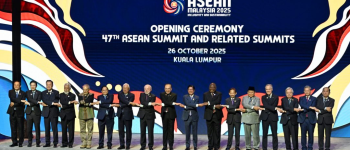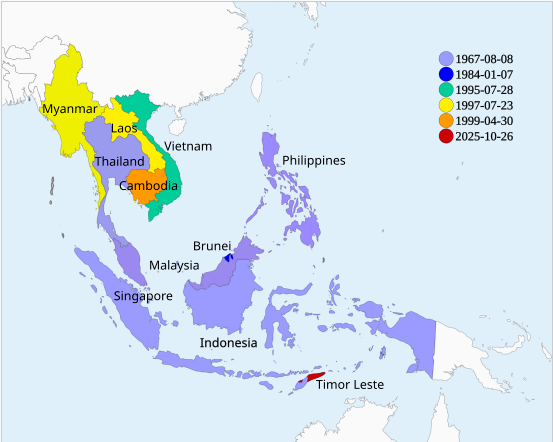ASEAN and Its Significance for India
31st Oct 2025
Read

TABLE OF CONTENTS
- About Association of Southeast Asian Nations (ASEAN)
- ASEAN's Economic and Geopolitical Significance
- ASEAN- India Relations
- Challenges within ASEAN and Implications for India
- Way Forward for India
In News- In News: The 47th ASEAN Summit was held in Kuala Lumpur on October 28, 2025. It highlighted ASEAN's growing importance amid changing global power dynamics, the US-China trade tensions, and the rising focus on the Indo-Pacific region.
About Association of Southeast Asian Nations (ASEAN)

- It is a regional intergovernmental organization established in 1967 through the ASEAN Declaration (Bangkok Declaration). Its headquarters is located in Jakarta, Indonesia.
- ASEAN currently comprises 11 member states — Brunei, Cambodia, Indonesia, Laos, Malaysia, Myanmar, the Philippines, Singapore, Thailand, Vietnam, and Timor-Leste, which joined the grouping in *2025 during the 47th ASEAN Summit in Kuala Lumpur, Malaysia.
- The primary objective of ASEAN is to promote economic growth, political stability, social progress, and security cooperation among Southeast Asian nations through mutual respect for sovereignty, non-interference in internal affairs, and consensus-based decision-making.
ASEAN's Economic and Geopolitical Significance
- Economic Powerhouse:ASEAN is the world's fifth-largest economy, with intra-regional trade between 25-30%—second only to the European Union. Its collective dynamism and youthful demographics make it a vital hub for global supply chains and manufacturing.
- Geostrategic Location:Situated at the intersection of the Indian and Pacific Oceans, ASEAN lies at the heart of the Indo-Pacific. It is a critical conduit for global trade—almost 40-50% of India's maritime trade transits through the ASEAN region, particularly via the South China Sea.
- Stability and Regional Order: The ASEAN-led architecture—including the East Asia Summit (EAS), ASEAN Regional Forum (ARF), and ASEAN Defence Ministers' Meeting Plus (ADMM+)—provides an institutional framework for dialogue and cooperation, offering India a platform to shape regional norms and stability.
- Collective Global Voice: Despite internal diversity, ASEAN has managed to speak with a relatively unified voice on major global issues, thereby amplifying its diplomatic influence.
ASEAN- India Relations
- Historical and Cultural Links: The ties between India and Southeast Asia date back to ancient times through trade, religion, and cultural exchanges—evident in the spread of Buddhism, Hinduism, and Sanskrit influence. These civilisational links underpin contemporary cooperation.
- Act East Policy and Connectivity Projects:
- India-Myanmar-Thailand Trilateral Highway and the Kaladan Multi-Modal Transit Transport Project aim to physically connect India's Northeast with mainland Southeast Asia.
- Cooperation extends to digital connectivity, sustainable tourism, and people-to-people exchanges.
- Economic Engagement:
- India and ASEAN signed the ASEAN-India Trade in Goods Agreement (AITIGA) in 2009. However, India later realised an imbalance, as tariff concessions favoured ASEAN exports, allowing indirect Chinese goods entry into India.
- India has called for an early review of AITIGA to ensure balanced and mutually beneficial trade.
- India chose to stay out of the Regional Comprehensive Economic Partnership (RCEP) in 2020, citing concerns over market access and domestic industry protection.
- Strategic and Security Cooperation:
- India participates in ASEAN-led mechanisms like the East Asia Summit and ADMM+, engaging on maritime security, counterterrorism, and disaster management.
- ASEAN's centrality is integral to India's Indo-Pacific Oceans Initiative (IPOI), reflecting shared interests in freedom of navigation and rule-based maritime order.
Challenges within ASEAN and Implications for India
- Internal Divisions: The bloc's consensus-driven approach limits its ability to respond to crises, such as the democratic backsliding in Myanmar.
- China's Assertiveness: The South China Sea disputes and China's aggressive nine-dash line claims create tensions among member states and complicate ASEAN unity.
- Balancing Great Powers: ASEAN countries maintain a delicate equilibrium between the US (security partner) and China (economic partner). India must navigate this space prudently to avoid being drawn into great power rivalries.
Way Forward for India
- Consistency and Commitment: ASEAN's gradual but sustained integration shows the importance of consistent engagement and institution-building—lessons that can inform India's participation in regional groupings like BIMSTEC and BBIN.
- Economic Diplomacy: India should leverage its strengths in digital infrastructure, fintech, and healthcare to deepen economic interdependence with ASEAN.
- Maritime Cooperation: With 90% of India's trade by volume conducted via sea routes, maritime connectivity and joint security frameworks with ASEAN are essential for economic resilience.
- Regional Leadership: By engaging smaller economies through capacity-building and infrastructure partnerships, India can position itself as a reliable and responsible regional power.
Conclusion
For India, ASEAN is more than a regional partner — it is a key gateway to a stable and prosperous Indo-Pacific. Stronger ties in trade, connectivity, and security will be vital for India's regional and global goals. The success of India's Act East Policy and Indo-Pacific vision depends on how well it works with ASEAN's shared priorities and central role.
Source- IE

Author: Lemo
Lemo is the quiet observer of the UPSC world. He writes when the city sleeps, fueled by black coffee and the ticking clock. As the visionary behind Epoch IAS, he crafts notes that are short, sharp, and always a step ahead of the syllabus — trusted by aspirants burning the midnight oil.
Feel free to use images in our website by simply providing a source link to the page they are taken from.
-- Epoch IAS
Explore By Category
Latest Posts
Share views on ASEAN and Its Significance for India
Please keep your views respectful and not include any anchors, promotional content or obscene words in them. Such comments will be definitely removed and your IP be blocked for future purpose.
.png) 8th Aug 2025
8th Aug 2025
 9th Aug 2025
9th Aug 2025
 29th Jul 2025
29th Jul 2025
 30th Oct 2025
30th Oct 2025
 27th Aug 2025
27th Aug 2025
 29th Jul 2025
29th Jul 2025
 29th Jul 2025
29th Jul 2025
 29th Oct 2025
29th Oct 2025
